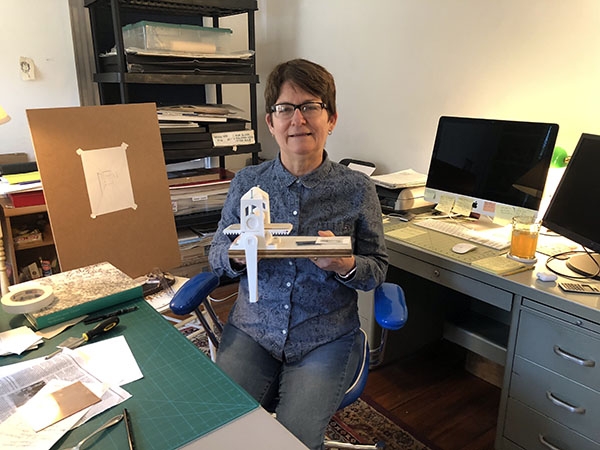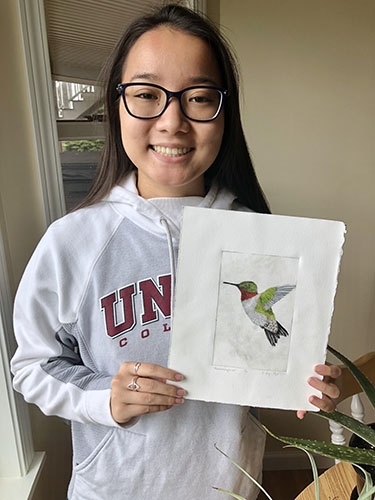Printmaking is about making impressions.
Sandy Wimer is out to make one of her own, showing students that the pandemic is an opportunity to innovate and to appreciate the healing power of art.
The senior lecturer of art has retooled her class on printmaking and etching as a remote studio experience that can be done without the large and heavy presses in the Feigenbaum Center for Visual Arts.
Before the term began, Wimer sent supplies to her 10 students. Kits included ink, copper and plexiglass plates, etching tools, watercolors and paper. She encourages the use of household items. A spoon, for example, is used to apply pressure required to transfer ink to paper. “I couldn’t believe it, but … it is working,” Wimer said.
The class meets in synchronous three-hour Zoom studio sessions. After introductions and directions from Wimer, the students work on their dry point etchings. “When they have a question, the rest of the class hears the question and answer,” she said. “They are learning from each other, an important element in a studio class.”
The studio sessions also provide an escape. “I remind my students that it is healthy to be making art during this time,” Wimer said. “I think it has a healing quality, even when you get frustrated with how an image is emerging.”
Natalie Berg-Pappert, a first-year art major, agrees. “Making art has definitely helped relieve my stress, one from the pandemic, but also from my other classes,” she said from her home in Geneva, N.Y. “Art has always provided a release because it allows me to forget about everything that’s been on my mind and just lets me focus on creating the one thing that’s in front of me.”
Wimer hesitates to call herself a “techie,” admitting she has had to step up for the class. But she has found plenty of help from colleagues. “I realize now the importance of the Union team,” Wimer said. “Without all these professional specialists, my online class would not be nearly as successful.”
She turned to Cole Belmont, director of Union’s Makerspace Consortium, to produce miniature presses by 3D printing to be sent to students at home. “They are over the moon excited about this,” Wimer said. “What is it about miniature that everyone likes? This way they will experience, in a very tiny way, how a press works.”
Julie Lohnes, director of art collections, facilitated a website for pieces from the College's Permanent Collection along with work by Wimer's former students. The site was created by Sarah Mottalini, curatorial assistant.
Wimer invited Sarah Schmidt, director of Special Collections, and Lohnes to do a presentation on hand-colored etchings using the College’s Birds of America prints by John James Audubon. Wimer hopes students can see the rare originals in Special Collections after pandemic restrictions are relaxed.
Robyn Reed, head of access services at Schaffer Library, facilitated a website for artwork by Wimer's current students that was created by Jenn Byrd, library web developer.
For Berg-Pappert, the course came as a relief. “I was very surprised (and excited) to see Sandy’s email before the term, telling us that they were going to send us the supplies for the course,” she said. “I had thought that the course was for sure going to be cancelled, but I was very glad to hear that the College was going to do everything they could to make sure that art classes and other hands-on courses would still happen.
“This is my first time printmaking and it amazes me that we can still make prints with such minimal equipment. It definitely gives me a larger understanding about the process and a broader appreciation for the discipline.”

